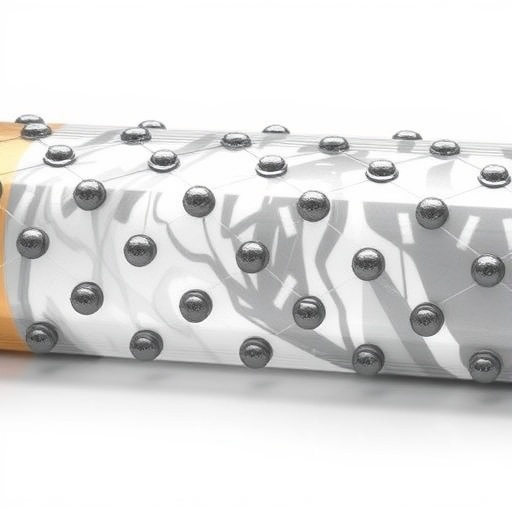A groundbreaking advance in lithium–sulfur battery technology has emerged from a dedicated research team led by Professors Xiaoyan Zheng, Huigang Zhang, and Tao Yang. Published in the esteemed journal Nano-Micro Letters, their study introduces an ingeniously engineered heterojunction catalyst composed of CoWO4 and WO2. This novel catalyst harnesses the power of intercalation-mediated catalysis alongside metallic conductivity to solve two persistent challenges in lithium–sulfur batteries: sluggish polysulfide conversion and the notorious shuttle effect. Their innovative design not only accelerates redox kinetics but also stifles unwanted polysulfide migration, marking a vital stride towards practical and long-lasting Li–S batteries.
Lithium–sulfur batteries are heralded for their exceptional energy density and cost-effective materials, yet they grapple with intrinsic obstacles that stall their commercial viability. Central among these is the formation and dissolution of lithium polysulfides during charge-discharge cycles. These polysulfides tend to diffuse freely within the electrolyte, causing an irreversible loss of active material and deteriorating the battery’s lifespan—a phenomenon widely recognized as the shuttle effect. Moreover, achieving efficient and rapid catalytic conversion of these polysulfides has proven challenging. Traditional catalysts often face a trade-off between strong adsorption capacity and adequate electronic conductivity, limiting their overall efficacy in real-world applications.
The innovative CoWO4/WO2 heterojunction developed by this research team tackles these issues by synergistically integrating multiple functionalities into a single architectural framework. At its core, the CoWO4 component exhibits robust chemisorption properties for lithium polysulfides, effectively weakening the sulfur-sulfur bonds and thereby lowering the energy barrier needed for their conversion. This strong adsorption capacity ensures that polysulfides remain localized at the cathode interface, significantly mitigating their diffusion into the electrolyte.
Complementing this, the WO2 phase introduces metallic conduction pathways that serve as efficient electron highways, a feature critically absent in many conventional Li–S catalysts. This metallic WO2 not only boosts overall electrical conductivity but also acts as an electron donor to the CoWO4 counterparts. The electron donation enhances catalytic sites’ electronic density and activity, facilitating faster and more efficient polysulfide redox reactions. The result is a finely tuned interface where electron and ion transport processes are harmoniously optimized.
Beyond electronic conductivity and chemical adsorption, the CoWO4 phase furnishes directional channels tailored for lithium-ion intercalation—a vital feature rarely integrated into Li–S catalysts. These intercalation channels act as lithium reservoirs, enabling rapid ion diffusion and ensuring continuous ion transport during extensive cycling. This aspect of catalyst design promotes sustained catalytic action without the usual interruption caused by ionic bottlenecks, paving the way for higher sulfur utilization rates under both normal and demanding operational conditions.
The heterointerface formed between CoWO4 and WO2 engenders profound charge redistribution and orbital hybridization. This charge transfer dynamic at the heterojunction promotes superior activation of lithium-sulfur bonds and streamlines the electron and ion flow during polysulfide conversion. Such synergy at the atomic level sharpens catalytic precision and efficiency, inviting a new paradigm of multifunctional catalysts tailored for energy storage applications.
Performance evaluations unequivocally substantiate the success of this heterojunction design. The CoWO4/WO2 catalyst exhibits a remarkable specific capacity of 1262 mAh per gram at a moderate 0.1 C rate, eclipsing performance metrics from single-component systems. Notably, this enhanced capacity does not sacrifice rate capability. The catalyst maintains stable discharge voltage profiles marked by well-defined dual plateaus and low polarization across a wide range of current densities, underscoring its robustness under rapid charge–discharge conditions.
Cycling stability, often the Achilles’ heel of lithium–sulfur batteries, receives a substantial boost from this catalytic architecture. At practical sulfur loading levels of 1 mg cm⁻², the electrode demonstrates an impressively low capacity decay rate of merely 0.038% per cycle sustained over 1000 cycles. Even under more demanding conditions, such as high sulfur loading of 5 mg cm⁻², the system retains 79.1% of its initial capacity after 235 cycles, illustrating its feasibility for real-world energy storage.
Crucial mechanistic insights gleaned from in situ Raman spectroscopy and X-ray diffraction techniques confirm the catalyst’s efficiency in polysulfide conversion and validate effective shuttle suppression. These analyses reveal negligible polysulfide dissolution into the electrolyte, corroborating the engineered catalyst’s ability to hamper the shuttle effect while promoting full utilization of active sulfur species.
This pioneering study not only promises transformative advancements in lithium–sulfur battery design but also opens avenues for a broader class of next-generation multifunctional catalysts. By interlacing adsorption, catalytic conversion, and ion transport into a unified heterojunction framework, the CoWO4/WO2 system provides a powerful blueprint. Such a framework can be extended to other heterostructures that strategically combine metallic conductivity with ion-intercalating hosts, offering a scalable approach to tailor catalysts for wide-ranging electrochemical energy storage applications.
Looking ahead, the intercalation-mediated catalysis concept unveiled here may redefine the landscape of battery material research. It offers the potential for developing scalable, high-energy, and long-cycle-life lithium–sulfur batteries essential for electric vehicles, grid storage, and portable electronics. Continued refinement and integration of these catalytic heterostructures could bridge the gap between laboratory breakthroughs and commercial lithium–sulfur batteries, addressing key hurdles in energy density, longevity, and stability.
In sum, this research delivers an elegantly engineered catalyst that moves lithium–sulfur batteries closer to widespread adoption by resolving fundamental mechanistic challenges. Through the meticulous orchestration of chemical adsorption, metallic electron transport, and lithium-ion intercalation within a singular heterojunction architecture, the study sets a new benchmark for multifunctional catalysts. As energy demands surge globally, innovations such as this provide a beacon of hope for sustainable and high-performance energy storage technologies.
Subject of Research: Lithium–sulfur batteries, catalyst development, heterojunction interfaces, intercalation-mediated catalysis.
Article Title: Metallic WO2-Promoted CoWO4/WO2 Heterojunction with Intercalation-Mediated Catalysis for Lithium–Sulfur Batteries
News Publication Date: 18-Jul-2025
Web References: 10.1007/s40820-025-01849-3
Image Credits: Chan Wang, Pengfei Zhang, Jiatong Li, Rui Wang, Changheng Yang, Fushuai Yu, Xuening Zhao, Kaichen Zhao, Xiaoyan Zheng, Huigang Zhang, Tao Yang.
Keywords
Lithium–sulfur batteries, catalyst design, heterojunction, CoWO4, WO2, intercalation, polysulfide conversion, shuttle effect suppression, electrochemical energy storage, metallic conductivity, ion transport, high capacity




